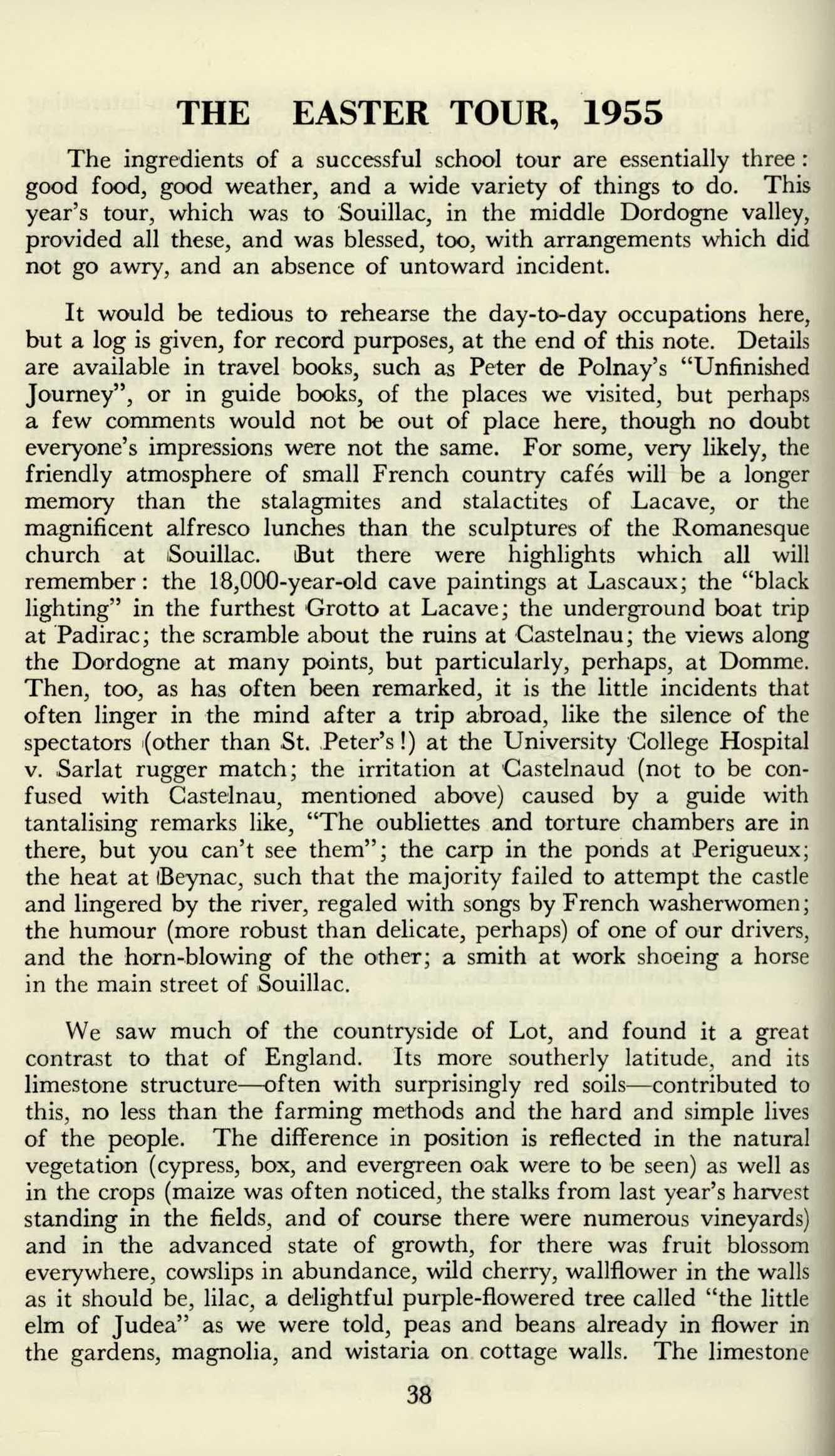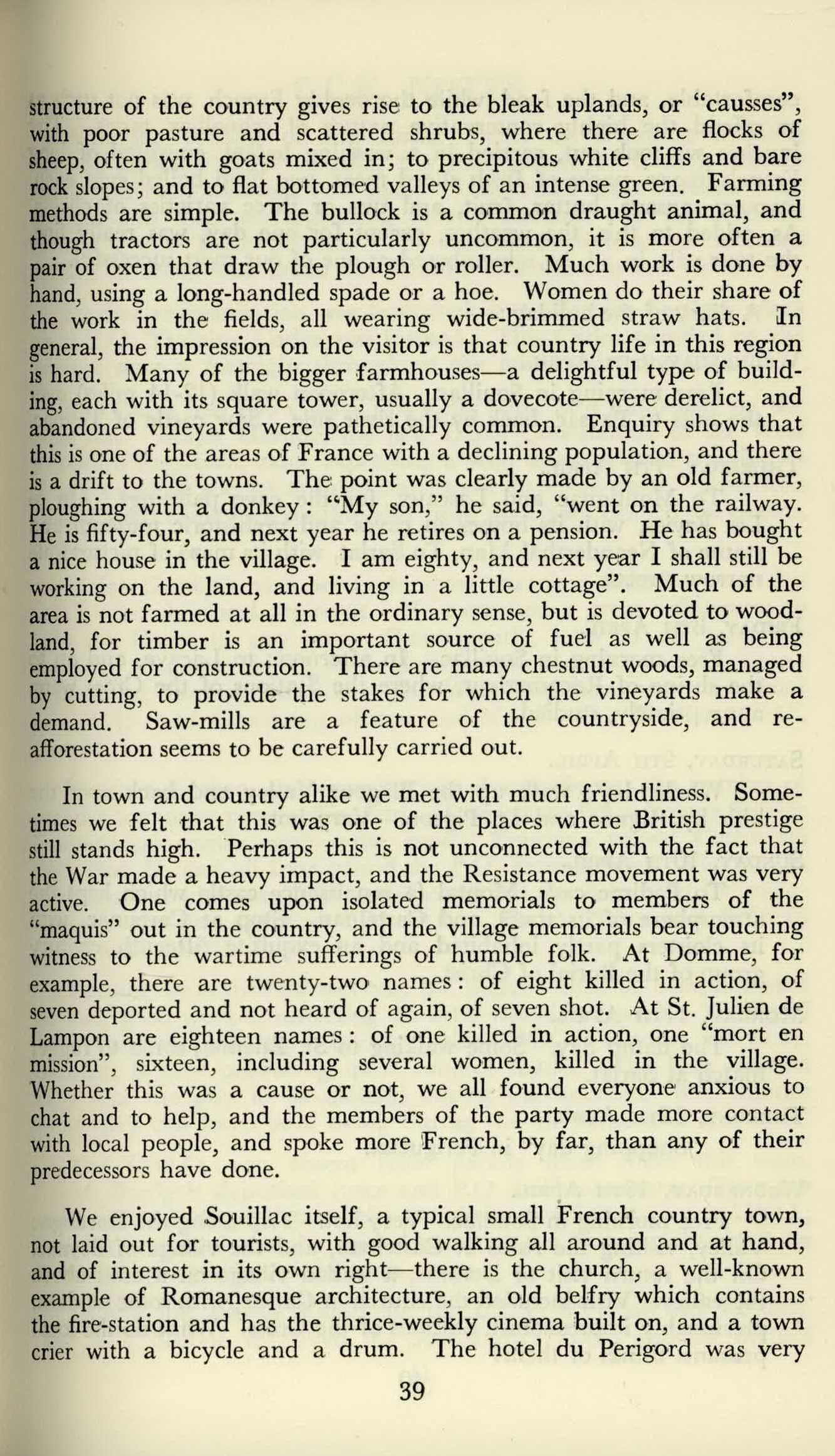
6 minute read
The Easter Tour
from May 1955
by StPetersYork
THE EASTER TOUR, 1955
The ingredients of a successful school tour are essentially three : good food, good weather, and a wide variety of things to do. This year's tour, which was to Souillac, in the middle Dordogne valley, provided all these, and was blessed, too, with arrangements which did not go awry, and an absence of untoward incident.
It would be tedious to rehearse the day-to-day occupations here, but a log is given, for record purposes, at the end of this note. Details are available in travel books, such as Peter de Polnay's "Unfinished Journey", or in guide books, of the places we visited, but perhaps a few comments would not be out of place here, though no doubt everyone's impressions were not the same. For some, very likely, the friendly atmosphere of small French country cafes will be a longer memory than the stalagmites and stalactites of Lacave, or the magnificent alfresco lunches than the sculptures of the Romanesque church at Souillac. But there were highlights which all will remember : the 18,000-year-old cave paintings at Lascaux; the "black lighting" in the furthest Grotto at Lacave; the underground boat trip at Padirac; the scramble about the ruins at .Castelnau; the views along the Dordogne at many points, but particularly, perhaps, at Domme. Then, too, as has often been remarked, it is the little incidents that often linger in the mind after a trip abroad, like the silence of the spectators (other than St. Peter's !) at the University College Hospital v. Sarlat rugger match; the irritation at Castelnaud (not to be confused with Castelnau, mentioned above) caused by a guide with tantalising remarks like, "The oubliettes and torture chambers are in there, but you can't see them"; the carp in the ponds at Perigueux; the heat at Beynac, such that the majority failed to attempt the castle and lingered by the river, regaled with songs by French washerwomen; the humour (more robust than delicate, perhaps) of one of our drivers, and the horn-blowing of the other; a smith at work shoeing a horse in the main street of Souillac.
We saw much of the countryside of Lot, and found it a great contrast to that of England. Its more southerly latitude, and its limestone structure—often with surprisingly red soils—contributed to this, no less than the farming methods and the hard and simple lives of the people. The difference in position is reflected in the natural vegetation (cypress, box, and evergreen oak were to be seen) as well as in the crops (maize was often noticed, the stalks from last year's harvest standing in the fields, and of course there were numerous vineyards) and in the advanced state of growth, for there was fruit blossom everywhere, cowslips in abundance, wild cherry, wallflower in the walls as it should be, lilac, a delightful purple-flowered tree called "the little elm of Judea" as we were told, peas and beans already in flower in the gardens, magnolia, and wistaria on cottage walls. The limestone 38
structure of the country gives rise to the bleak uplands, or "causses", with poor pasture and scattered shrubs, where there are flocks of sheep, often with goats mixed in; to precipitous white cliffs and bare rock slopes; and to flat bottomed valleys of an intense green. Farming methods are simple. The bullock is a common draught animal, and though tractors are not particularly uncommon, it is more often a pair of oxen that draw the plough or roller. Much work is done by hand, using a long-handled spade or a hoe. Women do their share of the work in the fields, all wearing wide-brimmed straw hats. In general, the impression on the visitor is that country life in this region is hard. Many of the bigger farmhouses—a delightful type of building, each with its square tower, usually a dovecote—were derelict, and abandoned vineyards were pathetically common. Enquiry shows that this is one of the areas of France with a declining population, and there is a drift to the towns. The point was clearly made by an old farmer, ploughing with a donkey : "My son," he said, "went on the railway. He is fifty-four, and next year he retires on a pension. He has bought a nice house in the village. I am eighty, and next year I shall still be working on the land, and living in a little cottage". Much of the area is not farmed at all in the ordinary sense, but is devoted to woodland, for timber is an important source of fuel as well as being employed for construction. There are many chestnut woods, managed by cutting, to provide the stakes for which the vineyards make a demand. Saw-mills are a feature of the countryside, and reafforestation seems to be carefully carried out.
In town and country alike we met with much friendliness. Sometimes we felt that this was one of the places where British prestige still stands high. Perhaps this is not unconnected with the fact that the War made a heavy impact, and the Resistance movement was very active. One comes upon isolated memorials to members of the "maquis" out in the country, and the village memorials bear touching witness to the wartime sufferings of humble folk. At Domme, for example, there are twenty-two names : of eight killed in action, of seven deported and not heard of again, of seven shot. At St. Julien de Lampon are eighteen names : of one killed in action, one "mort en mission", sixteen, including several women, killed in the village. Whether this was a cause or not, we all found everyone anxious to chat and to help, and the members of the party made more contact with local people, and spoke more French, by far, than any of their predecessors have done.
We enjoyed Souillac itself, a typical small French country town, not laid out for tourists, with good walking all around and at hand, and of interest in its own right—there is the church, a well-known example of Romanesque architecture, an old belfry which contains the fire-station and has the thrice-weekly cinema built on, and a town crier with a bicycle and a drum. The hotel du Perigord was very 39

comfortable, and the food, while thoroughly French, was not such as to offend the highly conservative nature of schoolboy tastes. The lunches we took out, carried in a washing basket, consisted of long French loaves, packs of fresh sliced meat, two hard boiled eggs each, savoury sausage, butter, fruit, and two or three varieties of cheese. As, added to this, the weather, except for one day, was really fine, the tour will, in all, be remembered as one of our most successful.
A diary of the holiday :-
WEDNESDAY, 6TH APRIL. Free morning in Souillac. Afternoon walk 02-14 miles) over the hills to Paysac, back by the river side. Saw castle of Teynac.
THURSDAY, 7TH APRIL. To Montignac and Lascaux, for the cave paintings. On to
Les Ezyies, with its houses in caves and prehistoric museum and statue of Neanderthal Man. To Sarlat, with its maze of picturesque narrow streets.
FRIDAY, 8TH APRIL. Free morning in Souillac. In afternoon to Lacave, and on to the shrine of Rocamadour, where the Stations of the Cross were, appropriately, studied.
SATURDAY, 9TH APRIL. Whole day's walk up the Blagour Valley and back over the hills by Rignac and Le Pigeon. Very hot. SUNDAY, 10TH APRIL. To Padirac cave, Montal (a renaissance castle which kept the atmosphere of its time), and Castelnau. Stop at Carennac, with its cloisters partly inhabited and an exquisite fifteenth century group of the Burial of Christ. MONDAY, 11TH APRIL. The damp day. Some walking to St. Etienne; some to rugger match at Sarlat.

TUESDAY, 12TH APRIL. "Shopping day" in 1Perigueux. WEDNESDAY, 13TH APRIL. Free morning in Souillac. Very hot. Trip along the Dordogne
Valley, visiting the ruins at CasteInau, and the village of Beynac.
On the return visit to Domme, a walled village on a crest above the valley. Visit included the church at Carsac, with some modern, presumably impressionist, Stations of the Cross. What do the local peasants thinks of them?










